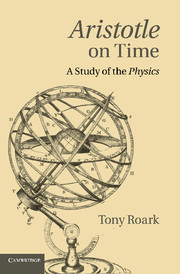Book contents
- Frontmatter
- Contents
- Preface
- List of figures
- List of abbreviations
- Introduction
- PART I TIMES NEW AND OLD
- PART II THE MATTER OF TIME: MOTION
- PART III THE FORM OF TIME: PERCEPTION
- PART IV SIMULTANEITY AND TEMPORAL PASSAGE
- 11 Simultaneity and other temporal relations
- 12 Temporal passage
- 13 Dissolving the puzzles of iv.10
- 14 Concluding summary and historical significance
- References
- Index locorum
- General index
11 - Simultaneity and other temporal relations
Published online by Cambridge University Press: 03 May 2011
- Frontmatter
- Contents
- Preface
- List of figures
- List of abbreviations
- Introduction
- PART I TIMES NEW AND OLD
- PART II THE MATTER OF TIME: MOTION
- PART III THE FORM OF TIME: PERCEPTION
- PART IV SIMULTANEITY AND TEMPORAL PASSAGE
- 11 Simultaneity and other temporal relations
- 12 Temporal passage
- 13 Dissolving the puzzles of iv.10
- 14 Concluding summary and historical significance
- References
- Index locorum
- General index
Summary
Now that we have examined both the matter and the form of time, the hylomorphic analysis is technically complete. However, there are residual issues of importance that need to be addressed. To my knowledge, no commentator of Aristotle has attempted to analyze his notion of simultaneity, but the hylomorphic interpretation has ready to hand an obvious and effective analysis of this temporal relation. The analysis points up the importance of celestial motion within the theory, and we shall have to examine some of Aristotle's remarks in the Physics and other treatises on natural philosophy to fully appreciate the status and role of celestial motion in his account.
The most daunting residual issue concerns Aristotle's treatment of temporal passage and related matters about the present or “now.” There is substantive disagreement over the question of whether Aristotle treats time as being essentially static (as it is in McTaggart's B series) or dynamic (as in his A series). I shall prepare the ground for the hylomorphic view on this issue by examining the interpretations of Richard Sorabji and Fred Miller, both of whom argue that Aristotle fails to integrate temporal passage into his theory in a satisfactory way. Taking this line of argument considerably further, Norman Kretzmann claims that Aristotle, like McTaggart, believes that there is a contradiction inherent in the notion of temporal passage. The hylomorphic interpretation is inconsistent with all of these views.
Information
- Type
- Chapter
- Information
- Aristotle on TimeA Study of the Physics, pp. 179 - 192Publisher: Cambridge University PressPrint publication year: 2011
